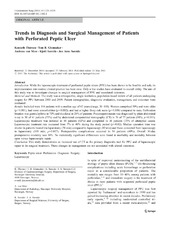Trends in Diagnosis and Surgical Management of Patients with Perforated Peptic Ulcer
Peer reviewed, Journal article
Published version
Permanent lenke
https://hdl.handle.net/1956/5241Utgivelsesdato
2011-05-13Metadata
Vis full innførselSamlinger
Originalversjon
https://doi.org/10.1007/s11605-011-1482-1Sammendrag
Introduction While the laparoscopic treatment of perforated peptic ulcers (PPU) has been shown to be feasible and safe, its implementation into routine clinical practice has been slow. Only a few studies have evaluated its overall utility. The aim of this study was to investigate changes in surgical management of PPU and associated outcomes. Material and Methods The study was a retrospective, single institution, population-based review of all patients undergoing surgery for PPU between 2003 and 2009. Patient demographics, diagnostic evaluation, management, and outcomes were evaluated. Results Included were 114 patients with a median age of 67 years (range, 20–100). Women comprised 59% and were older (p<0.001), had more comorbidities (p=0.002), and had a higher Boey risk score (p=0.036) compared to men. Perforation location was gastric/pyloric in 72% and duodenal in 28% of patients. Pneumoperitoneum was diagnosed by plain abdominal x-ray in 30 of 41 patients (75%) and by abdominal computerized tomography (CT) in 76 of 77 patients (98%; p<0.001). Laparoscopic treatment was initiated in 48 patients (42%) and completed in 36 patients (75% of attempted cases). Laparoscopic treatment rate increased from 7% to 46% during the study period (p=0.02). Median operation time was shorter in patients treated via laparotomy (70 min) compared to laparoscopy (82 min) and those converted from laparoscopy to laparotomy (105 min; p=0.017). Postoperative complications occurred in 56 patients (49%). Overall 30-day postoperative mortality was 16%. No statistically significant differences were found in morbidity and mortality between open versus laparoscopic repair. Conclusion This study demonstrates an increased use of CT as the primary diagnostic tool for PPU and of laparoscopic repair in its surgical treatment. These changes in management are not associated with altered outcomes.

